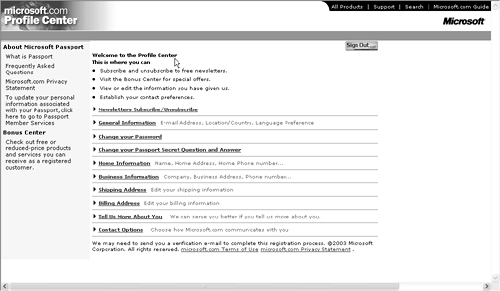User Profile
| < Day Day Up > |
User ProfileIf you allow users to log into the portal, you need a personal profile for each user. At a minimum, the profile contains the username and password used for authentication. It may also contain data elements such as:
Users should have access to their profiles so they can ensure their accuracy and change them as profile information changes. For instance, Figure 2.4 shows the profile-updating page at microsoft.com. Figure 2.4. Personal Profile Page at microsoft.com Profiles usually grow over time. It may be too intrusive to ask a user for all the information in the profile at one time. Depending on what actions a user takes in the portal, more information may be needed. There is no point in asking users for dietary preferences until it is time to serve them a meal, such as a meal at a conference. When users travel, you may need to expand their profiles to include seating preferences and next -of-kin contact information. The profile is a rich source of information about your users. You can combine it with web log usage statistics to better understand who likes what on your portal. The profile may help with directed marketing campaigns through direct mail or email. The profile is also the basis for personalization. |
| < Day Day Up > |
EAN: 2147483647
Pages: 164
